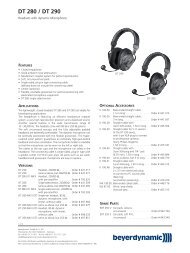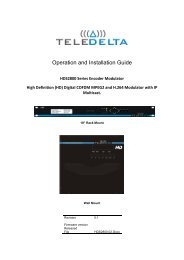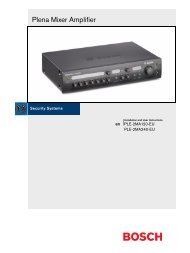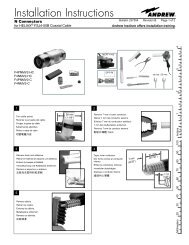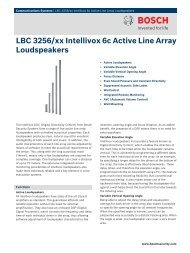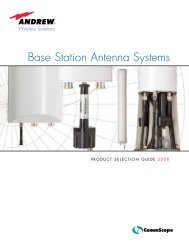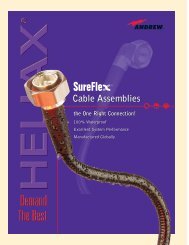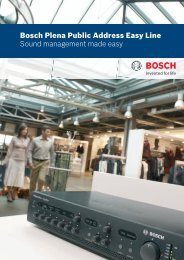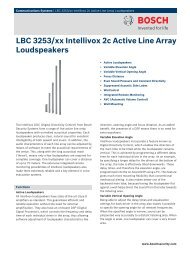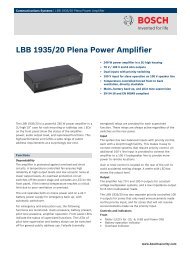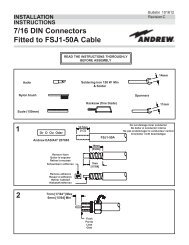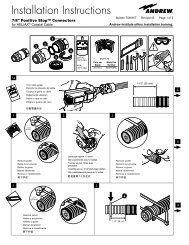Rane Note 110: Sound System Interconnection - AVW
Rane Note 110: Sound System Interconnection - AVW
Rane Note 110: Sound System Interconnection - AVW
Create successful ePaper yourself
Turn your PDF publications into a flip-book with our unique Google optimized e-Paper software.
The Absolute Best Right Way To Do ItThe method specified by AES48 is to use balanced linesand tie the cable shield to the metal chassis (right whereit enters the chassis) at both ends of the cable.A balanced line requires three separate conductors,two of which are signal (+ and –) and one shield(see Figure 1a). The shield serves to guard the sensitiveaudio lines from interference. Only by using balancedline interconnects can you guarantee (yes, guarantee)hum-free results. Always use twisted pair cable. Chassistying the shield at each end also guarantees the bestpossible protection from RFI [radio frequency interference]and other noises [neon signs, lighting dimmers].Neil Muncy 1 , an electroacoustic consultant andseasoned veteran of years of successful system design,chairs the AES Standards Committee (SC-05-05)working on this subject. He tirelessly tours the worldgiving seminars and dispensing information on how tosuccessfully hook-up pro audio equipment 2 . He makesthe simple point that it is absurd that you cannot goout and buy pro audio equipment from several differentmanufacturers, buy standard off-the-shelf cable assemblies,come home, hook it all up and have it work humand noise free. Plug and play. Sadly, almost never isthis the case, despite the science and rules of noise-freeinterconnect known and documented for over 60 years(see References for complete information).It all boils down to using balanced lines, only balancedlines, and nothing but balanced lines. This is whythey were developed. Further, that you tie the shield tothe chassis, at the point it enters the chassis, and at bothends of the cable (more on ‘both ends’ later).Since standard XLR cables come with their shieldstied to pin 1 at each end (the shells are not tied, norneed be), this means equipment using 3-pin, XLR-typeconnectors must tie pin 1 to the chassis (usually calledchassis ground) — not the audio signal ground as ismost common.Not using signal ground is the most radical departurefrom common pro-audio practice. Not that thereis any argument about its validity. There isn’t. This isthe right way to do it. So why doesn’t audio equipmentcome wired this way? Well, some does, and since 1993,more of it does. That’s when <strong>Rane</strong> started manufacturingsome of its products with balanced inputs andoutputs tying pin 1 to chassis. So why doesn’t everyonedo it this way? Because life is messy, some things arehard to change, and there will always be equipment inuse that was made before proper grounding practiceswere in effect.Unbalanced equipment is another problem: it iseverwhere, easily available and inexpensive. All thoseRCA and ¼" TS connectors found on consumer equipment;effect-loops and insert-points on consoles; signalprocessing boxes; semi-pro digital and analog taperecorders; computer cards; mixing consoles; et cetera.The next several pages give tips on how to successfullyaddress hooking up unbalanced equipment.Unbalanced equipment when “blindly” connected withfully balanced units starts a pattern of hum and undesirableoperation, requiring extra measures to correctthe situation.The Next Best Right Way To Do ItThe quickest, quietest and most foolproof method toconnect balanced and unbalanced is to transformerisolate all unbalanced connections. See Figure 2.Many manufacturers provide several tools for thistask, including <strong>Rane</strong>. Consult your audio dealer to explorethe options available.The goal of these adaptors is to allow the use ofstandard cables. With these transformer isolationboxes, modification of cable assemblies is unnecessary.Virtually any two pieces of audio equipment can besuccessfully interfaced without risk of unwanted humand noise.UNBALANCEDBALANCEDCOMMON (WRONG) PRACTICECASERECOMMENDED PRACTICE(+)NOT CONNECTEDAT CHASSIS(PLASTIC JACK)TRANSFORMER21(+) CASEOPTIONAL23 (–)31(–)1/4”TIP-SLEEVE321CASE LUG MAYCONNECT TOCHASSIS(NOT REQUIRED)CHASSISGROUNDSIGNALGROUNDCHASSISGROUNDCHASSISGROUNDEARTH GROUNDEDMETAL ENCLOSURECHASSIS ISGROUNDED TO PIN 1Figure 1b. Recommmended practice.Figure 2. Transformer Isolation<strong>Interconnection</strong>-
Another way to create the necessary isolation is touse a direct box. Originally named for its use to convertthe high impedance, high level output of an electricguitar to the low impedance, low level input of a recordingconsole, it allowed the player to plug “directly”into the console. Now this term is commonly used todescribe any box used to convert unbalanced lines tobalanced lines.The Last Best Right Way To Do ItIf transformer isolation is not an option, specialcable assemblies are a last resort. The key here is toprevent the shield currents from flowing into a unitwhose grounding scheme creates ground loops (hum)in the audio path (i.e., most audio equipment).It is true that connecting both ends of the shield istheoretically the best way to interconnect equipment–though this assumes the interconnected equipment isinternally grounded properly. Since most equipment isnot internally grounded properly, connecting both endsof the shield is not often practiced, since doing so usuallycreates noisy interconnections.A common solution to these noisy hum and buzzproblems involves disconnecting one end of the shield,even though one can not buy off-the-shelf cables withthe shield disconnected at one end. The best end to disconnectis the receiving end. If one end of the shield isdisconnected, the noisy hum current stops flowing andaway goes the hum — but only at low frequencies. Aground-receiving-end-only shield connection minimizesthe possibility of high frequency (radio) interferencesince it prevents the shield from acting as an antennato the next input. Many reduce this potential RF interferenceby providing an RF path through a small capacitor(0.1 or 0.01 microfarad ceramic disc) connectedfrom the lifted end of the shield to the chassis. (This isreferred to as the “hybrid shield termination” where thesending end is bonded to the chassis and the receivingend is capacitively coupled. See Neutrik’s EMC-XLRfor example.) The fact that many modern day installersstill follow this one-end-only rule with consistentsuccess indicates this and other acceptable solutions toRF issues exist, though the increasing use of digital andwireless technology greatly increases the possibility offuture RF problems.If you’ve truly isolated your hum problem to a specificunit, chances are, even though the documentationindicates proper chassis grounded shields, the suspectunit is not internally grounded properly. Here is wherespecial test cable assemblies, shown in Figure 3, reallycome in handy. These assemblies allow you to connectthe shield to chassis ground at the point of entry, or topin 1, or to lift one end of the shield. The task becomesmore difficult when the unit you’ve isolated has multipleinputs and outputs. On a suspect unit with multiplecables, try various configurations on each connectionto find out if special cable assemblies are needed atmore than one point.See Figure 4 for suggested cable assemblies for yourparticular interconnection needs. Find the appropriateoutput configuration (down the left side) and thenmatch this with the correct input configuration (acrossthe top of the page.) Then refer to the following pagesfor a recommended wiring diagram.Ground LiftsMany units come equipped with ground lift switches.In only a few cases can it be shown that a ground liftswitch improves ground related noise. (Has a groundlift switch ever really worked for you?) In reality, thepresence of a ground lift switch greatly reduces a unit’sability to be “properly” grounded and therefore immuneto ground loop hums and buzzes. Ground liftsare simply another Band-Aid ® to try in case of groundingproblems. It is true that an entire system of properlygrounded equipment, without ground lift switches,is guaranteed (yes guaranteed) to be hum free. Theproblem is most equipment is not (both internally andexternally, AC system wise) grounded properly.Most units with ground lifts are shipped so the unitis “grounded” — meaning the chassis is connected toaudio signal ground. (This should be the best and isthe “safest” position for a ground lift switch.) If afterhooking up your system it exhibits excessive hum orFEMALE2C 31REDBLACKSHIELD2-CONDUCTOR SHIELDED CABLEREDBLACKSHIELDMALE231TESTWIRE<strong>Interconnection</strong>-Figure 3. Test cableGROUND CLIP
uzzing, there is an incompatibility somewhere in thesystem’s grounding configuration. In addition to thesespecial cable assemblies that may help, here are somemore things to try:1. Try combinations of lifting grounds on units suppliedwith lift switches (or links). It is wise to do thiswith the power off!2. If you have an entirely balanced system, verify allchassis are tied to a good earth ground, for safety’ssake and hum protection. Completely unbalancedsystems never earth ground anything (except cableTV, often a ground loop source). If you have a mixedbalanced and unbalanced system, do yourself a favorand use isolation transformers or, if you can’t dothat, try the special cable assemblies described hereand expect it to take many hours to get things quiet.May the Force be with you.3. Balanced units with outboard power supplies (wallwarts or “bumps” in the line cord) do not ground thechassis through the line cord. Make sure such unitsare solidly grounded by tying the chassis to an earthground using a star washer for a reliable contact.(<strong>Rane</strong> always provides this chassis point as an externalscrew with a toothed washer.) Any device witha 3-prong AC plug, such as an amplifier, may serveas an earth ground point. Rack rails may or may notserve this purpose depending on screw locations andpaint jobs.Floating, Pseudo, and Quasi-BalancingDuring inspection, you may run across a ¼" outputcalled floating unbalanced, sometimes also called psuedo-balancedor quasi-balanced. In this configuration,the sleeve of the output stage is not connected insidethe unit and the ring is connected (usually through asmall resistor) to the audio signal ground. This allowsthe tip and ring to “appear” as an equal impedance,not-quite balanced output stage, even though the outputcircuitry is unbalanced.Floating unbalanced often works to drive either abalanced or unbalanced input, depending if a TS orTRS standard cable is plugged into it. When it hums, aspecial cable is required. See drawings #11 and #12, anddo not make the cross-coupled modification of tyingthe ring and sleeve together.Winning the Wiring Wars• Use balanced connections whenever possible, withthe shield bonded to the metal chassis at both ends.• Transformer isolate all unbalanced connectionsfrom balanced connections.• Use special cable assemblies when unbalanced linescannot be transformer isolated.• Any unbalanced cable must be kept under 10 feet(3 m) in length. Lengths longer than this will amplifyall the nasty side effects of unbalanced circuitry'sground loops.SummaryIf you are unable to do things correctly (i.e. use fullybalanced wiring with shields tied to the chassis at bothends, or transformer isolate all unbalanced signalsfrom balanced signals) then there is no guarantee thata hum-free interconnect can be achieved, nor is there adefinite scheme that will assure noise-free operation inall configurations.References1. Neil A. Muncy, “Noise Susceptibility in Analog and DigitalSignal Processing <strong>System</strong>s,” presented at the 97th AESConvention of Audio Engineering Society in San Francisco,CA, Nov. 1994.2. Grounding, Shielding, and <strong>Interconnection</strong>s in Analog& Digital Signal Processing <strong>System</strong>s: Understanding theBasics; Workshops designed and presented by Neil Muncyand Cal Perkins, at the 97th AES Convention of AudioEngineering Society in San Francisco, CA, Nov. 1994.3. The entire June 1995 AES Journal, Vol. 43, No. 6, available$6 members, $11 nonmembers from the Audio EngineeringSociety, 60 E. 42nd St., New York, NY, 10165-2520.4. Phillip Giddings, Audio <strong>System</strong> Design and Installation(SAMS, Indiana, 1990).5. Ralph Morrison, Noise and Other Interfering Signals(Wiley, New York, 1992).6. Henry W. Ott, Noise Reduction Techniques in Electronic<strong>System</strong>s, 2nd Edition (Wiley, New York, 1988).7. Cal Perkins, “Measurement Techniques for DebuggingElectronic <strong>System</strong>s and Their Instrumentation,” The Proceedingsof the 11th International AES Conference: AudioTest & Measurement, Portland, OR, May 1992, pp. 82-92(Audio Engineering Society, New York, 1992).8. Macatee, <strong>Rane</strong><strong>Note</strong>: “Grounding and Shielding AudioDevices,” <strong>Rane</strong> Corporation, 1994.9. Philip Giddings, “Grounding and Shielding for <strong>Sound</strong> andVideo,” S&VC, Sept. 20th, 1995.10. AES48-2005: AES standard on interconnections —Grounding and EMC practices — Shields of connectorsin audio equipment containing active circuitry (AudioEngineering Society, New York, 2005).Band-Aid is a registered trademark of Johnson & Johnson<strong>Interconnection</strong>-
CABLECONNECTORSTo InputMALEBALANCED XLR¼" BALANCEDTRS (TIP-RING-SLEEVE)¼" OR 3.5mmUNBALANCEDTS (TIP-SLEEVE)UNBALANCED RCABALANCEDEUROBLOCKFEMALE BALANCED XLR(NOT A TRANSFORMER,NOR A CROSS-COUPLEDOUTPUT STAGE)1 2 3 4BB+ to +– to –SHIELD ONLYTO EUROBLOCKFEMALE BALANCED XLR(EITHER A TRANSFORMEROR A CROSS-COUPLEDOUTPUT STAGE)1256+ to +– to –SHIELD ONLYTO EUROBLOCKFrom Output¼” BALANCED TRS(NOT A TRANSFORMER,NOR A CROSS-COUPLEDOUTPUT STAGE)¼” BALANCED TRS(EITHER A TRANSFORMEROR A CROSS-COUPLEDOUTPUT STAGE)¼” FLOATING UNBALANCEDTRS (TIP-RING-SLEEVE)(SLEEVE IN UNIT = NC)7721A8822A9B111<strong>110</strong>B1212+ to +– to –SHIELD ONLYTO EUROBLOCK+ to +– to –SHIELD ONLYTO EUROBLOCK+ to +– to –GROUND to GROUND¼” OR 3.5 mmUNBALANCEDTS (TIP-SLEEVE)131415A16 23AUNBALANCED RCA(TIP-SLEEVE)171819A20A23BALANCEDEUROBLOCK+ to +– to –SHIELD ONLYTO XLR PIN 1+ to +– to –SHIELD ONLYTO TRS SLEEVE2424+ to +– to –GROUND to GROUNDFigure 4. Interconnect chart for locating correct cable assemblies on the following pages.<strong>Note</strong>: (A) This configuration uses an “off-the-shelf” cable.<strong>Note</strong>: (B) This configuration causes a 6 dB signal loss. Compensate by “turning the system up” 6 dB.<strong>Interconnection</strong>-
<strong>Interconnection</strong>-
©<strong>Rane</strong> Corporation 10802 47th Ave. W., Mukilteo WA 98275-5098 USA TEL 425-355-6000 FAX 425-347-7757 WEB www.rane.com<strong>Interconnection</strong>- DOC 102907



